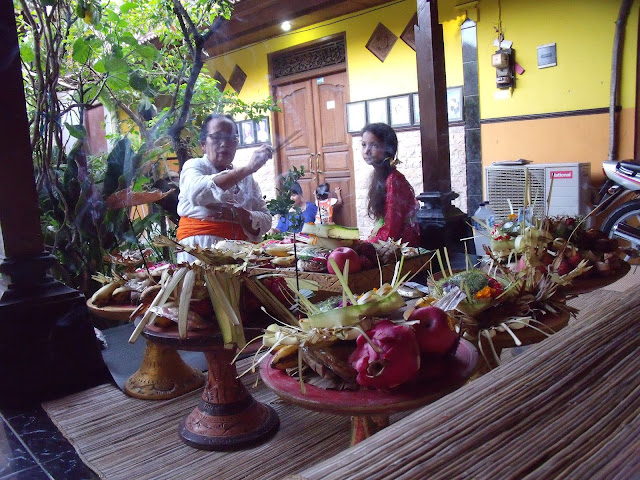One of Rites
of passage rituals “Oton Menek Kelih”on the Island of Bali
Hi
travelers,
For more info about Bali:
Photo by Ekarini
I hope you
enjoy Bali as much as I do. Bali island
is not only about beautiful beaches, natural landscapes, temples, spectacular hotels and SPAs, and please don’t
forget, Bali has so many ceremonies and Rites of passage rituals. Here I will
take you to look at closely of Balinese Rites of passage called “Oton Menek Kelih.”
“Menek
Kelih” is a Balinese ceremony for Balinese boys and girls. This ceremony symbolized the transition from
a little kid to a mature person. With
this ceremony, we hope that our children will be ready for all things in their
lives, as they grow more mature. Before
the ceremony begins, the boys and the girls have to wear Balinese traditional
outfits and other accessories.
“Menek Kelih” Balinese B-Day celebration is:
Manggah Daa and Mango Tirana. Puberty, the first menstruation of a girl or
by the deepening of the voice of a boy and the obvious development of the
genitals, is the occasion of the mango daa (virgin girl) or teruna (virgin boy) ceremony. It is also sometimes called Ngaraja Swala or
Menek Kelih for boys. The ceremony most
often given only for the girls of the family, since changes in their physical
and biological status are more pronounced than those of boys. This may be a very elaborate ceremony, with
all the trimmings, in the case of a wealthy or high caste people.
The ritual
emphasis here is two-fold. One involves
what is sometimes thought of as “marriage” with Sang Hyang Semara Ratih is also
the bisexual symbol of sexual union.
Semara – Ratih is also the symbol of beauty and is able to guarantee
success in all ventures, cure sickness, and chase away evil. The second emphasis is upon attaining skill
in the household chores that every girl must master. And the girl may go through the motions of
these actions with real props. Along
with the sexual features of the ceremony go prayers that the girl will be of
high moral standards and will raise her family in such a way that they will be
righteous and pure.
The most
important part of this ceremony is for the person to present the offerings
called biakala and prayascita, which is to ward off evil
spirits and purify the body, then to pray in the kitchen, and finally to “natab” the offering of a type called sayut.
This is an offering made to the deified ancestors and is for the purpose
of asking their blessings, to pray for happiness and success, and to ward off
evil. In the case of a girl the offering
is called sayut sabuh rah, “spattering of blood,” and in the case
of a boy sayut ngeraja sangha, “lion
king.” And finally, there must be a
ceremony of the bed… which includes some obvious sexual symbolism.
Photo by Ekarini
Thanks to Bali: Sekala
& Niskala: Sekala & Niskala book
Tips and temple ceremony etiquette
- Always wear a sarong and sash.
- Do not walk in front of people
when they are praying.
- Do not use flash or point your
camera at the priest’s face!
- Never sit higher than the
priest, the offerings and/or people praying.
- During cremation ceremonies,
never get in the way of the attendees
- Women are not allowed to enter
temples during menstruation.





No comments:
Post a Comment